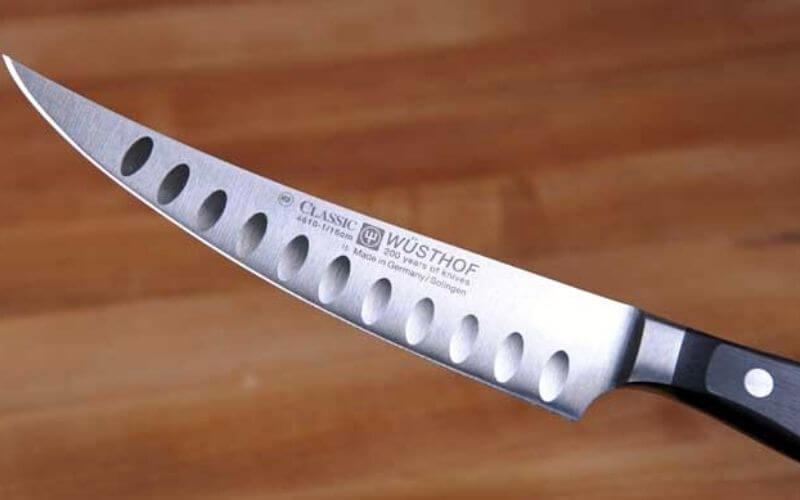This post contains affiliate links to products. We may receive a commission for purchases made through these links. But it never influences our product selection process.
One of the best experiences in life is to have a well-cut, hearty meal with your family at the dinner table. Most people do not think too much about the knives they are using for cooking.
If you are about to say, boning knives are for butchers only, then my friend you haven’t explored a wonderful part of the culinary world.
It doesn’t take much to learn how to use a boning knife but with learning comes so many options for you to explore. Investing in a good boning knife is mandatory whether you are a home cook, a butcher, or a professional chef.
So for you, we have gathered our top 14 picks of the best honing knives out there. Our list is very diverse with different price ranges and purposes.
Before we dive deep into it, let’s figure out what a boning knife really is.
What is a Boning Knife?
If you are not familiar with boning knives, the reason probably is, it’s a specialty knife. Boning knife is designed for de-boning and reshaping meat and fishes. Usually, they are found in professional kitchens and butcher shops.
Boning knives have different construction and look than your average kitchen knives. It is around 5-8 inches in size and has a narrower, sharper blade.
The blade is oftentimes very flexible to let you glide it effortlessly in between bones. Whether you are a professional chef or a cooking enthusiast, having a boning knife can improve your kitchen skills tremendously.
This is why we have gathered our top 14 list of the best boning knife out there. But before we get into the review, let’s have a quick overview of our cherry-picked options.
Best Boning Knives — An Overview
RankPictureNameShops#1
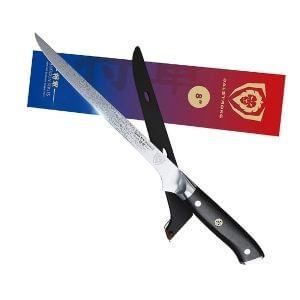
Dalstrong Shogun Series 8″ Flexible Boning Knife
- 67-Layer Damascus sharpened Blade.
- Ancient 3-step Honbazuke method
- AUS-10V Japanese super steel core
- Hand-crafted for the butcher, fishmonger, pitmaster, or any culinary professionals
Read Our Review
Check Price
#2
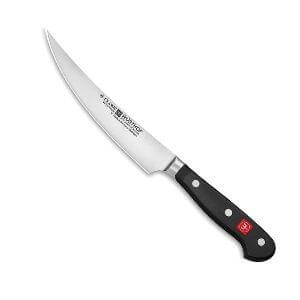
Wüsthof Classic Curved Boning Knife
- Precision-forged with a full tang.
- High carbon stainless steel.
- Triple-riveted handle.
Read Our Review
Check Price
#3
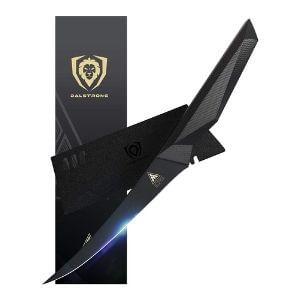
Dalstrong- Curved Boning Knife – 6″ – Shadow Black Series
- High carbon ThyssenKrupp German steel at 58 Rockwell
- Fiber-resin military-grade G10 handle
- Beautiful hand-polished satin finish blade.
Read Our Review
Check Price
#4
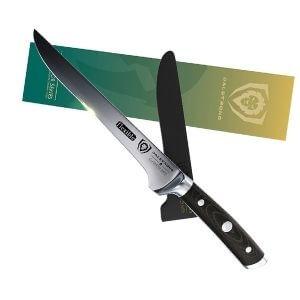
Dalstrong – Gladiator Series – Boning Knife
- High carbon German ThyssenKrupp steel at 56+ Rockwell
- Military-grade G10 garolite handle
- Suitable for professional use
Read Our Review
Check Price
#5
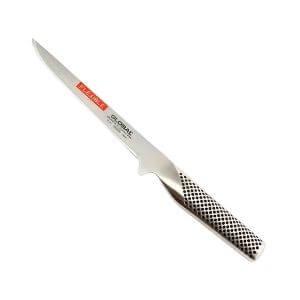
Global 6.25″ Boning Knife
- Lightweight, precisely balanced knife.
- The edge retains razor sharpness exceptionally well.
- Stainless-steel handle molded for comfort.
Read Our Review
Check Price
#6
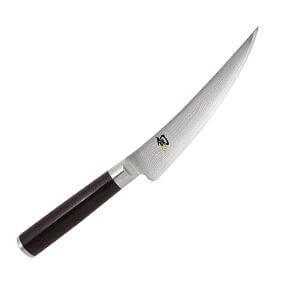
Shun Cutlery Classic Boning and Fillet Knife
- Damascus-clad blade with VG-MAX steel.
- Easily fillet fish using a razor-sharp blade.
- D-Shaped handle, secure grip for excellent control.
Read Our Review
Check Price
#7
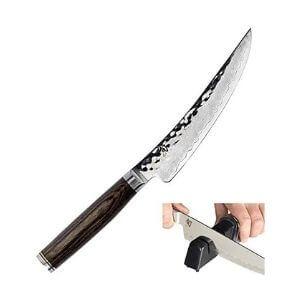
Shun Premier Gokujo Boning Fillet Knife
- Double-bevel flat-ground blade
- VG-Max Cutting Core for maximum edge retention.
- Hand-sharpened 16-degree cutting angle
Read Our Review
Check Price
#8
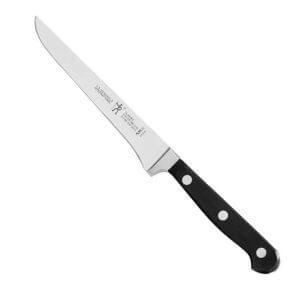
Henckels Classic Boning Knife
- High-quality German stainless steel
- Professional, satin-finished blade.
- Ergonomic, traditional triple-rivet handle.
Read Our Review
Check Price
#9
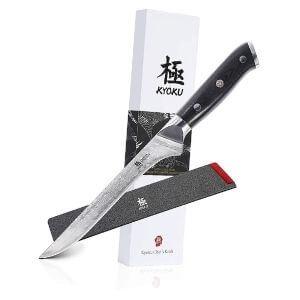
KYOKU Daimyo Series – Boning Knife
- VG-10 Japanese Damascus steel cutting core.
- The tapered bolster gives a perfect balance/
- 8-12° double side using the traditional 3-step Honbazuke method.
- Nitrogen cooled for ultimate hardness.
Read Our Review
Check Price
#10
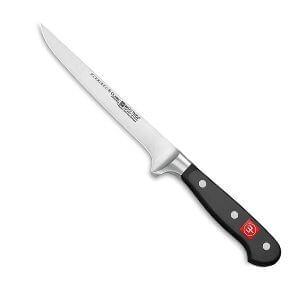
Wüsthof 4603 Boning Knife
- Comfortable and highly-durable.
- Razor sharp blade with a traditional look and feel.
- Ergonomic shape.
#11
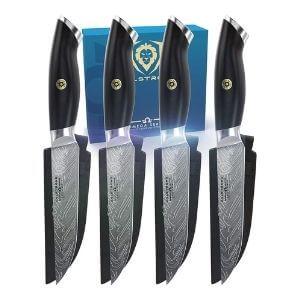
Dalstrong – Boning Knife – 6″ – Omega Series
- Scalpel like sharpness at a staggering 8-12°degree angle per side.
- Incredible Edge Retention at 63+ Rockwell.
- 67-Layered Damascus sharpened under the ancient 3-step Honbazuke method.
- A perfect ‘zero-balance’ knife.
#12
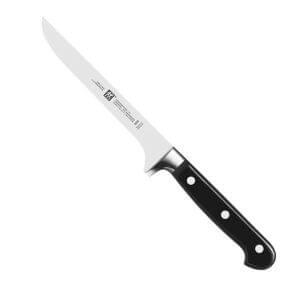
Zwilling J.A Henckels Professional Boning Knife
- Special formula high carbon no-stain steel.
- Ice-hardened friodur blade.
- 57 Rockwell hardness, excellent edge retention
#13
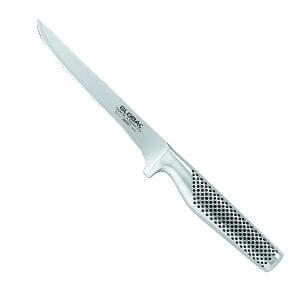
Global GF-31 Boning Knife
- Blade made of high-tech molybdenum/vanadium stainless steel.
- Handle molded for comfort, dimpled for safe grip.
- Lifetime warranty against defects and breakage
#14
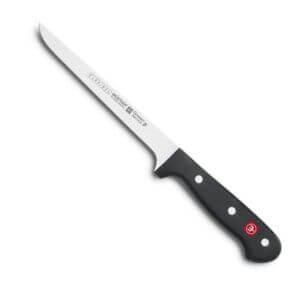
Wüsthof Gourmet 6 Inch Boning Knife
- Laser-cut stamped from one piece of specially tempered high-carbon stainless steel.
- Specially developed synthetic handle.
- Full-tang handle.
- Resists corrosion and dulling
Our Reviews of the
Best 14 Boning Knives
01. Dalstrong Shogun Series 8″ Flexible Boning Knife

Dalstrong SS_Boning
Top Pick!
FEATURES
- Blade Material: AUS-10V Japanese Super Steel
- Brand: Dalstrong
- Color: Stainless Steel
- Handle Material: G10 military-grade
- Blade Edge: Boning/Fillet
- Item Size: 8”
- Item Weight: 1 pounds
This boning knife by Dalstrong has a staggering 8-12° angle per side using the traditional 3-step Honbazuke method.
Even though it is slightly longer than a typical boning knife, the length almost feels like an extension of the arm. It cuts long, single slices of meat like butter and reduces wrist and hand fatigue for those longer high-volume preparations.
Ultra-sharp AUS 10V Japanese super steel blade provides extraordinary performance. The moment you hold it in your hand, you will feel the weight and quality.
This is not your average boning knife. Designed to be ideal for butchers, fishmonger, pitmaster, or any culinary professionals, this knife has a 62+ Rockwell hardness level and edge retention.
It has 67 layers of premium high-carbon stainless steel that provide durability, strength, and long term stain resistance.
The handle is hand-polished with ergonomic shape. The military-grade G10 handle provides lifelong durability. All Dulstrong knives have these signature features.
Did we mention it is highly impervious to temperature change? This Dalstrong Shogun Series 8” flexible boning knife is heat, cold, and moisture resistant.
The intricate copper mosaic enhances the beauty of this knife along with its distinctive engraves end cap. Dalstrong is famous for its beautifully designed knives with great customer care service.
Why I Recommend:
The Damascus cladding is stunning. This knife has the quality to last forever for a residential kitchen if it is well cared for. It’s sharp and the right size for many cutting tasks.
Pros:
- German Steel and military-grade materials.
- Super sharp blade.
- Comfortable handle.
- Mosaic adornment on the handle
- Comes in a nice packaging.
- Giftable
- Great value for money.
Cons:
- Not very flexible
Check the Latest Price for Dalstrong Shogun Series 8″ Flexible Boning Knife
02. Wüsthof Classic Curved Boning Knife

Wusthof 4610-7/16
Best Overall
FEATURES
- Blade material: Stainless Steel
- Brand: Wüsthof
- Color: Black, Stainless Steel
- Blade Ddge: Boning/Fillet
- Item Dimensions: 11.22 x 1.3 x 0.51 inches
Wüsthof Classic boning knife is made using precision forging, an effective knife making technique for durable construction.
To make a knife like this, they use a specially trained craftsman who heats up the metal and pounds it into shape. This makes the knife highly balanced and sturdy.
Wüsthof Classic boning knife comes with a triple-riveted handle that provides excellent grip while chopping or cutting.
Made in Solingen, Germany, you know this knife is made to last. It is made with high, carbon stainless steel, a lightweight yet durable material.
The 58 Rockwell hardness level tells you everything you need to know about its premium durability. You can toss it in the dishwasher without any worry of scratches or damage.
Even though it is on the pricier side, it’s a great investment for any passionate homecook, chef, or butcher.
Why I Recommend:
This knife provides great performance for everyday meat rep and increases efficiency with its fine, sharp blade and compact size. With easy functionality and solid form, this is a great investment piece.
Pros:
- Easy to use.
- Ergonomic handle and shape.
- A highly balanced blade and handle give comfort.
- Great value for money.
- The curved point makes it more versatile.
- The semi-stiff blade is ideal for beginners.
- Does not require constant sharpening.
- Holds the edge with exceptional balance.
Cons:
- The size might be too small if you are used to larger boning knives.
Check the Latest Price for Wüsthof Classic Curved Boning Knife
03. DALSTRONG- Curved Boning Knife – Shadow Black Series

DALSTRONG 6″
Best Value
FEATURES
- Blade Material: High Carbon Premium Steel
- Color: Matte Shadow Black
- Handle Material: G10 Military Grade
- Length: 6”
- Blade Angle: 16-18°
- Coating: Titanium-nitride
Dalstrong Curved Boning Knife comes in a menacing sleek design with a unique sense of style. The moment you will hold this knife you will be able to feel the exceptional craftsmanship.
This boning knife has a really sharp scalpel-like edge that is hand-finished by expert bladesmiths to 15° per side. They used the traditional Honbazuke method to achieve that.
The blade has a titanium nitride non-reflective coating. This not only improves the looks of the knife but also makes it robust and corrosion-resistant.
Crafted from a single piece of steel, this cutting-edge boning knife is flexible and durable for years of use.
The fiber-resin military-grade G10 handle of the Dalstrong boning knife is hand-polished and is slightly textured to provide anti-slip properties. The shape is ergonomic to provide maximum comfort.
The blade itself is high-carbon German steel with added vacuum heat treatment at 58+ Rockwell hardness. This means you get really good edge retention.
It has added chromium for stain resistance. You can use this knife for decades without a single scratch on it.
The tall blade height gives excellent maneuvering and knuckle clearance for super fast chopping. As it has a non-stick coating, you can clean it really easily.
Why I Recommend it:
Professional quality boning knife with a modern, sleek look to it. It doesn’t matter which level of knife skills you have. With a good knife like this, you will be able to cut through meat like butter.
Pros:
- Easy to hold.
- Ergonomic blade and handle.
- Durable and sturdy.
- Solid metal construction, built to last.
- Professional boning knife.
- Precise, thin cuts.
- Lightweight and razor-sharp blade.
- Great value for money.
- Money-back guarantee and lifetime warranty.
Cons:
- The blade needs regular sharpening to hold its shape.
Check the Latest Price for DALSTRONG- Curved Boning Knife
04. DALSTRONG – Gladiator Series – Boning Knife

Dalstrong
Editors Pick
FEATURES
- Blade Material: High Carbon German Steel
- Brand: Dalstrong
- Color: Stainless Steel
- Handle Material: G10 Garolite
- Blade Edge: Boning/ Fillet
- Item Size: 6”
- Item Weight: 6.5 ounces
Dalstrong calls their Gladiator Series “Battle Ready Cutlery” for their imported premium quality high-carbon ThyssenKrupp German steel and precision-forged blade.
This knife is hand-sharpened at a 14-16° angle that gives it the signature ultra-thin slicing and dicing ability with minimal effort.
Dalstrong Gladiator Boning knife is a high-performance kitchen knife that will help you do de-boning, filleting, skinning, trimming, and butterflying with utmost efficiency and satisfaction.
The narrow blade of this knife is shaped to glide along the contours of the bones effortlessly.
It comes with a beautifully designed ergonomic and ambidextrous handle that is constructed out of G10 garolite.
Garolite is an incredibly strong military-grade inert non-porous fiberglass like material.
The handle is highly impervious to both heat and moisture which means you can use this knife with minimal maintenance.
To keep your fingers safe from this knife, it comes with knuckle protection and a sturdy handle that won’t slip or budge no matter what.
Why I Recommend:
This knife has just enough flex on the tip to maneuver in and around bones and joints, and just the right amount of stiffness to cut through membranes. The quality and sharpness of the blade is absolutely amazing and the construction of the handle is quality workmanship.
Pros:
- Ultra-sharp, wear-resistant blade.
- Tapered design for hardness and flexibility.
- Added chromium for stain resistance.
- Polished spine for a comfortable pinch grip.
- Engraved Dalstrong center rivet.
- Ergonomic handle shape.
- Low maintenance.
- Giftable design and packaging.
- Great value for money.
Cons:
- Not very suitable for filleting.
Check the Latest Price for DALSTRONG – Gladiator Series – Boning Knife
05. Global 6.25″ Boning Knife

Global G-21
Authentic Japanese Style
FEATURES
- Blade Material: Stainless Steel
- Brand: Global
- Color: Silver
- Handle Material: Stainless Steel
- Item Dimension: 0.24 inches
This is a really unique and unconventional looking boning knife. The best thing about the Global boning knife is its full stainless steel construction and the lightweight feature.
Global Knives is a Japanese brand that provides alternatives and better options to traditional European style cutleries. This all-steel knife is just a small example of their creativity.
Made from hard molybdenum/vanadium stainless steel, the blades are extremely sharp and can be quite dangerous if you are not careful with it. This is not a knife for a casual cook.
If you are used to using European style boning knives, you would notice the edges of this knife have a more acute angle. This allows you to make extra thin slices. Perfect for trimming fat or making precise cuts.
This is a high maintenance knife. You won’t get the performance from any other knives but for that, you need to take extra care.
This is not a knife you use randomly and throw in the dishwasher. The blade requires regular sharpening and care but the result is quite rewarding.
If you are concerned that the handle will slip as it’s stainless steel, no need to worry. The handle is molded to fit into the palm of your hand. The dimpled style is added for a safe grip and a distinct look.
Global also focuses a lot on the balance of their knives. To achieve the right balance, they inject a precise amount of sand into the hollow handles. To ensure that the balance is continuous, the sand flows inside when you move the blade.
Why I Recommend This Knife:
This is a really awesome boning knife that has little to no cons. It glides through tendons and cartilage and can be turned mid-cut. Not suitable for beginners though.
Pros:
- Easy to hold.
- Balanced body.
- Sharp and stays sharp for a long time after use.
- A great gift.
- Ideal for de-boning or filleting a fish faster.
- Flexible blade.
- Worth the money.
Cons:
- Comes in a box without a sheath.
Check the Latest Price for Global 6.25″ Boning Knife
06. Shun Cutlery Classic Boning and Fillet Knife

Shun DM0743
Best for Fish
FEATURES
- Blade Material: Damascus-clad VG-MAX steel
- Brand: Shun
- Color: Stainless Steel
- Handle Material: PakkaWood
- Blade Edge: Boning/Fillet
- Item Size: 6”
- Item Weight: 7 ounces
“Shun” or “shoon” is a concept that is very close to the heart of Japanese culture. In Japan this word means something that is —at the peak of its perfection.
Shun cutlery is globally known for its timeless beauty and premium quality. This boning knife by Shun is created following ancient Japanese methods and traditions. Totally handcrafted, each Shun knife takes at least 100 steps to complete.
Shun uses heat treatment to make the blade finder grained and much stronger in structure than any other boning knives.
With precise heat treatment, they are able to achieve the finer, thinner blade without losing the strength or integrity of it.
This Shun boning knife comes with a traditional Japanese Pakkawood D-shaped handle. It has a slight ridge on the right side which fits perfectly into your palm with a secure grip. Pakkawood has been used for centuries to make waterproof and sturdy handles.
The narrow curved blade is perfect for making sushi. The Damascus stainless steel blade is extremely razor-sharp and requires no physical effort whatsoever.
The authentic VG max steel of this blade provides excellent edge retention without losing the thinness of the knife.
Why I Recommend This Knife:
If you are looking for a very sharp knife that can fillet a fish effortlessly, this is the one to look into. It is incredibly sharp and thin. Perfect for making sushi, trimming tenderloins, cutting rib roasts into rib-eye.
Pros:
- Extremely sharp blade.
- Traditional Japanese style boning knife with authentic crafting method.
- Great value for money.
- Modern, premium materials.
- The D-shaped handle feels great to hold.
- Luxurious and handcrafted to perfection.
- Durable knife with a lifelong warranty.
Cons:
- As it’s a Japanese style knife, it might take a while to get used to the shape.
- Not very flexible.
Check the Latest Price for Shun Cutlery Classic Boning and Fillet Knife
07. Shun Premier Gokujo Boning Fillet Knife

Shun 6-Inch
Best for Poultry & Meat
FEATURES
- Blade Material: Stainless Steel
- Brand: Shun
- Color: Silver
- Handle Material: Pakkawood
- Blade Edge: Boning/Fillet
Shun Premier Gokujo boning knife is a symbol of the ancient handcrafted culture that has become obsolete due to the mass production of everything.
Shun is dedicated to bringing this well-loved tradition back to everybody’s life. They want to make Japanese knives a household staple again.
This boning and fillet knife is made by using old heat treatment —an invisible yet essential step of Japanese knife making.
In heat treatment, the metal is heated and cooled down over and over again to change its microstructure. This makes the metal resistant to force, temperature change, and rust.
As the blade is finer-grained, Shun makes their boning knife extra thin and sharp. This provides an excellent shelf life with a longer-lasting edge.
Premier Gokujo Boning and Fillet Knife are perfect for removing bones and creating paper-thin slices. It features a double-bevel flat ground.
The blade is hand-sharpened at a 16° cutting angle on each side. The hammered Tsuchine finish looks like it has come out of a storybook. This texture also helps release food when cutting.
The blade has 64 layers of stainless steel and a Walnut Pakkawood handle to fit both right and left hand. Talk about attention to detail!
Why I Recommend This Knife:
You can do precise work with this Shun knife. This is particularly great for carving meat. The length ensures that you can reach what you need to. As the tip is honed, it’s perfect for the hard to reach areas.
Pros:
- Extremely sharp.
- Stylish and functional.
- Well crafted blade.
- Authentic Japanese craftsmanship.
- Great investment piece.
Cons:
- Needs regular maintenance.
Check the Latest Price for Shun Premier Gokujo Boning Fillet Knife
08. KYOKU Daimyo Series – Boning Knife

KYOKU 8541905931
Best Balanced
FEATURES
- Blade Material: Japanese VG10 Core, 67-Layers Damascus Blade
- Brand: KYOKU
- Color: Silver
- Warranty: Life-time
- Blade Length: 7 Inches
- Item Dimensions: 12 x 1.35 x 1 inches
Kyoku Daimyo Boning Knife is made out of VG10 Japanese super steel, with an HRC of 58-60. Japanese steel is renowned for its stability and century-old steel cutting technology.
Added cobalt creates highly effective edge retention and proper balance.
This 7” boning knife or “Honesuki” is the most overall best choice for meat preparation. As the blade is flexible, you can bend it around bones to cut your desired piece.
Whether you like deboning, preparing, fileting, skinning, trimming, and butterflying, this knife will become your favorite go-to option for easy and efficient meat cutting.
The handle of the knife is constructed with military-grade wood. It has gone through many special treatments to make it extremely resilient to heat and moisture. No matter where you live, this will survive generations.
In the end, it doesn’t matter if the knife is super durable if it’s dull and dead. This knife, however. Is ruthlessly sharp and has a scalpel-like edge.
The blade is polished by experienced artisans and has a mirror-like finish. The knife is sharpened at 8-12° double side using the traditional 3-step Honbazuke method.
Kyoku Damascus Boning knife is cooled down with nitrogen to give ultimate hardness without making it fragile. You also get a lifetime warranty with a free of charge return policy!
Why I Recommend This Knife:
This is a beautiful boning knife. The Damascus blade has just the right amount of flex. The balance of the knife is amazing and undoubtedly, the best feature.
Pros:
- Full tang with engraved rivet and mosaic pin.
- Superior sharpness.
- Included knuckle guards.
- Ergonomic handle.
- Well balanced design.
- Japanese steel and construction.
- Lifetime warranty.
Cons:
- Not very flexible.
Check the Latest Price for KYOKU Daimyo Series – Boning Knife
09. DALSTRONG – Boning Knife – 6″ – Omega Series

Dalstrong Inc.
Best for Professionals
FEATURES
- Blade Material: Alloy Steel
- Brand: Dalstrong
- Color: Stainless Steel
- Handle Material: G10 woven fiberglass
- Blade Edge: Boning/Fillet
- Item Size: 6”
- Item Weight: 1.41 pounds
The Omega Series 6” boning and fillet knife is an essential tool every chef should have in their kitchen. It’s the perfect shape and size for deboning, filleting, skinning, trimming, and butterflying.
The narrow blade of this knife is shaped to effortlessly slice flesh ways with maximum flexibility.
The blade has a “LiquidMetal ” pattern that reduces drag. This also gives the knife a distinctive look.
The blade itself is made out of ultra-premium American forged hyper steel with an added vacuum treatment. The tapered bolster provides the best balance which makes chopping really effortless.
The knife is rust/ corrosion resistant with a hand-polished spine. The full tang gives it maximum robustness as well.
The edge retention of this knife is superb with 63+ Rockwell. The tempering is cryogenic which increases the steel’s crystalline structure and hardness.
Let’s talk about the handle of the Omega 6” boning knife. It has a military-grade G10 handle with an ergonomic shape and a non-slip grip.
The exterior of the handle is heat, cold, and moisture resistant.
Dalstrong is renowned for its well-designed handles. This one has superior hand control, comfort, and agility than anything else you have tried before.
The engraved end cap and oversized intricate copper mosaic give it a unique look and beauty. It’s very aesthetically pleasing to have in the kitchen.
Why I Recommend This Knife:
If you are someone who cuts meat on a regular basis, this can be a nifty option for you. It has a thin, sharp blade that can do fine cutting and trimming.
Pros:
- Ergonomic handle.
- Easy to hold.
- Super razor-sharp blade.
- Quality craftsmanship.
- Durable blade and handle.
- Great value for money.
Cons:
- The blade is too thin on the top which causes calluses easily.
Check the Latest Price for DALSTRONG – Boning Knife – 6″ – Omega Series
10. Zwilling J.A Henckels Professional Boning Knife

Henckels 31024-143
Best Reviews
FEATURES
- Blade Material: Stainless Steel
- Brand: HENCKELS
- Color: Black/Stainless Steel
- Blade Edge: Boning/Fillet
- Dimensions: 16.5 x 2.75 x 1.5 inches
Manufactured in Germany, this High carbon stainless steel boning knife is one of the best options for professional and at-home work.
This Sigma forge knife is forged from a single piece of solid steel. This means the strength and resistance of the blade are phenomenal.
To make it sturdy, they used the ice-hardened method. This fridour blade stays sharper and stays the same way for a long time. If you are someone who does not enjoy sharpening their knife, this can be a handy option.
The precision-honed blade has superior resilience and cuts meat at a natural curved angle. This means the blade simply glides through the meat.
The ergonomic polymer three-rivet handle feels good on hand. It is perfectly bonded to the full tang for durability and maneuverability.
Boasting a 57 Rockwell hardness, this knife has excellent edge retention. The steel is stain, corrosion, and heat resistant as well.
No knife is good unless it has a well-balanced body. The sturdy bolster gives J Henckels boning knife just the right balance and an ideal 15° cutting angle.
Why I Recommend This Knife:
This boning knife is the highest rated at American Test Kitchen and for good reasons. It is super flexible which means you can debone poultry, and meat both before and after cooking.
The thin blade and exquisite edge stay the same for a long time without much maintenance.
Pros:
- Fully visible tang provides proper balance.
- Non-staining and non-rusting stainless steel.
- Ergonomic shape.
- Super flexible.
- Durable, smooth, and comfortable handle.
- Dishwasher safe.
- Full warranty.
Cons:
- As it is really flexible, unless you are skilled, getting cuts is more likely to happen.
Check the Latest Price for Zwilling J.A Henckels Professional Boning Knife
11. Global GF-31 Boning Knife

Global GF-31
Best Heavyweight Option
FEATURES
- Blade Material: Stainless Steel
- Brand: Global
- Color: Stainless Steel
- Item Dimensions: 14.5 x 3.5 x 0.8 inches
- Item Weight: 0.66 Pounds
This is another great option from Global if you want to debone an entire rack of ribs without forcing the blade on it.
The knife is made from a single piece of high-quality CROMOVA 18 stainless steel. This knife has a very pointy tip with a narrow blade. This makes it great at going around the bones for precise cutting.
With this heavy-duty knife, you can debone and skin any cuts of beef easily to make spare ribs for your family or the barbecue party with buddies.
The ergonomic handle with a dimpled pattern makes it comfortable to hold with a no-slip grip. You can use it for repetitive slicing as the knife is filled with sand for perfect balance.
This is a great knife that is designed to be high-tech from top to bottom. Just like other Global Knives, this one is also handcrafted in Japan by experts.
This Heavyweight line is made for chefs who prefer heavy-duty cutlery. A certain amount of weight gives a better hold and feel.
Heavy knives feel premium and chop smoothly due to the weight of its own body.
So if you prefer heavyweight knives, this 6-1/4 inch boning knife will help you cut poultry and meat through joints like marshmallows.
Why I Recommend This Knife:
If you’re looking for a solid, heavy knife for ribs and other larger portions of meat, this is the best choice for you. Its bodyweight helps to force the blade to cut seamlessly.
Pros:
- Best at handling larger chunks of meat.
- Easy to handle.
- Well designed.
- Heavyweight and sturdy.
- Durable construction.
- Great value for money.
Cons:
- None! This knife does exactly what it says.
Check the Latest Price for Global GF-31 Boning Knife
12. Wüsthof Gourmet 6 Inch Boning Knife

Wusthof 4607-7
Super Flexible
FEATURES
- Blade Material: High Carbon Stainless Steel
- Brand: Wüsthof
- Color: Black
- Blade Edge: Boning/Fillet
- Item Dimensions: 11 x 1 x 1 inches
This 6” Wüsthof Gourmet boning knife with a synthetic handle provides excellent durability and value to your kitchen.
The blade is made out of high carbon stainless steel that resists corrosion and dulling. This German-made kitchen slice comes with a lifetime warranty as well.
The full-tang handle is made out of synthetic polypropylene that resists fading, discoloration, heat, and force.
Wüsthof is a family-owned seven-generation-long company that first started in Solingen, Germany around 200 years ago!
They are a reliable and trustworthy brand that has proven its worth over time.
This Gourmet Wüsthof boning knife has a long narrow curved blade. This enables it to move cleanly along the bones for clean, fine cuts. As it is quite flexible as well, you can use it to cut around smaller bones too.
This Gourmet Wüsthof line along with the boning knife is laser-crafted and built to create a sustainable future. Their motto is to make such durable products that people need to purchase once in their lifetime.
Why I Recommend This Knife:
If you need a flexible long knife to move along the bone and fatty parts of a large cut of meat, then this is the one for you. The flexibility in the blade makes this a superior choice to debone and butcher larger cuts. A must for your collection.
Pros:
- Thin bladed, flexible knife.
- Easy to hold.
- High quality, durable materials.
- Quality craftsmanship.
- Full tang, ergonomic handle.
- Razor-sharp and easy to sharpen.
Cons:
- The blade is too flexible for heavy cartilage.
Check the Latest Price for Wüsthof Gourmet 6 Inch Boning Knife
13. Wüsthof 4603 Boning Knife

Wusthof 4603
Best for Versatility
FEATURES
- Blade Material: Carbon Steel
- Brand: Wüsthof
- Color: Stainless Steel
- Handle Material: Polyoxymethylene
- Blade Edge: Boning
- Item Size: 6”
- Item Weight: 4.9 ounces
With this Wüsthof 4603 boning knife, you get a flexible design that can be used for a variety of things.
The long, narrow, and curved blade of this boning knife is perfect to maneuver around bones to make the best clean cut of pork, beef, and chicken.
The handle of this boning knife is made out of POM aka polyoxymethylene.
POM has a tighter molecular structure than other handle materials. This makes it resist fading and discoloration. You can use this knife for years and it will still look brand new.
Every Wüsthof knife takes a lot of extensive processes to create. This one is no different. It is forged in a 40-step process that starts with a single blank of high carbon stainless steel.
This boning knife is a full tang that is triple-riveted to the handle. This means you get maximum precision-level control.
It also comes with a full bolster and finger guard for the most optimal and comfortable grip.
The blade has been tempered to 58 degrees on the Rockwell Scale.
Wüsthof precision edge technology (PEtec) makes this blade 20% sharper with double edge retention. This means you don’t have to constantly resharpen it before each use.
Why I Recommend This Knife:
This knife has the ideal dimensions for just about any task you might assign it to. It can even be used for chopping vegetables. Due to the stainless steel, it doesn’t rust, stain, or gets dull.
Pros:
- Razor-sharp blade with edge retention.
- Perfect for skinning fishes easily.
- Well shaped with a good weight.
- Reasonable price.
- Well crafted blade, durably built.
- Takes minimal effort to resharpen.
Cons:
- Does not come with a sheath.
Check the Latest Price for Wüsthof 4603 Boning Knife
14. HENCKELS CLASSIC Boning Knife

HENCKELS CLASSIC
Best for Beginners
FEATURES
- Blade Material: Stainless Steel
- Brand: HENCKELS
- Color: Black/Stainless Steel
- Blade Edge: Boning/Fillet
- Item Dimensions: 13 x 3.75 x 1 inches
The Henckels Classic 5.5” Boning Knife gives a precision-cut with its fine-edge blade.
This longlasting knife is made in Spain from high-quality German stainless steel. As the construction of the blade is fully forged, you get a seamless transition from blade to handle.
As the blade and handle are one piece, it will survive years and years of abuse. You can use this boning knife with minimal maintenance and it will still perform better than average knives.
The blade has a satin finish that gives it a professional and sleek look. This makes it easier to clean too.
The ergonomic and traditional shape of the triple-rivet handle provides a great balance between the knife and the blade. This makes cutting and chopping relatively easy.
This knife is also dishwasher safe which means it’s scratch and corrosion-resistant. You get a high-quality experience with exceptional value.
Why I Recommend This Knife:
The blade is flexible enough to blend when you need it yet stiff enough to be able to cut through cartilage and smaller bones with minimal effort.
Pros:
- High quality German stainless steel provides excellent strength.
- Easy to hold.
- Solid, sharp, and flexible blade.
- Durable construction.
- Giftable choice.
- Great value for money.
Cons:
- Does not hold up well for heavy usage.
Check the Latest Price for HENCKELS CLASSIC Boning Knife
Buying Guide
If you are someone who isn’t familiar with boning knives, chances are you are quite lost to choose one for you.
Boning knives are not the same as your regular kitchen knives. They have a different shape and purpose in the kitchen. As the primary use of a boning knife is to cut meat and fish in any way you want, the knife needs to have certain features to be labeled as a good boning knife.
Types of Boning Knives:
There are many different types of boning knives depending on the blade or handle. However, the two most common types are: stiff and flexible.
Stiff:
A stiff boning knife is used to cut wider portions of thicker meat chunks. They usually have a broader blade and are used by butchers. These kinds of boning knives are not very common as you need a certain skill set to use one of those properly.
Flexible:
A flexible or semi-flexible boning knife is the most common type. They are used to cut difficult shapes.
Wüsthof Gourmet Flexible Boning Knife is one of the best out there.
As the blade can move any way you want, you can cut around the bones as well. Flexible boning knives are better for fish fillets or ribs. They are ideal for skinny as well.
Blade Type:
Boning knives also have different blade types, usually two main ones: straight and curved.
Straight:
A straight boning knife is ideal for thicker and larger chunks of meat, especially beef and pork. If you want to separate meat from the bone and trim away excess fat, using a straight knife is more efficient.
It can also be really good at sculpting and fine slicing. An authentic Japanese choice would be the Global 6.25″ Boning Knife.
Curved:
The curved boning knives are predominantly Japanese style knives that are often smaller and more flexible than European knives. They are the best at de-boning and really fine, paper-thin slices. Usually, sushi chefs use these kinds of knives.
Our best value choice is Dalstrong- Curved Boning Knife – 6″ – Shadow Black Series
Handle Design:
This is very important. Having a badly made handle can cause serious accidents. Imagine what would happen if the knife slips from your hand?
Usually, some popular materials for handles are plastic, polypropylene, rubber, and wood. All of these are excellent if done right.
The shape of the handle is totally your preference. Some people like thicker handles and some like thinner ones. A safe choice would be to pick an ergonomic shape that fits like a glove in your palms.
Look for boning knives with full tang and triple rivets features. These are the most durable types of handles. Something like Dalstrong – Gladiator Series – Boning Knife is great for that.
Size & Weight:
Most people prefer lightweight boning knives as they are easy to maneuver. You get excellent flexibility while cutting fish or meat with a knife like this.
Usually, stainless steel knives are the lightest. Carbon steel blades come in a close second. Lightweight knives come in all different sizes and shapes.
But if you like a good weight for your knives, you can go for heavier options. Heavy knives are usually longer to create the best balance. Check out Global GF-31 Heavyweight Boning Knife for a solid option.
Warranty :
As most boning knives are quite expensive and an investment piece, you would want to get the most out of your money. Look for knives with a lifetime warranty.
For example, Dalstrong – Gladiator Series Boning Knife comes with a lifetime warranty to provide ultimate customer satisfaction.
Some even give free replacement options in case your package gets damaged in the process.
Accessories:
Boning knives usually come with a case or stealth for easy storage. Some even go as far as to give sharpening steel with it. As boning knives are not used every day, you need a good case to store it properly.
Frequently Asked Questions (FAQs)
01. What is a boning knife used for?
A boning knife is a type of kitchen knife that has been used for centuries in meat preparation.
A good quality boning knife comes with a sharp edge and narrow, thin blade. You can use boning knives to remove bones from fish, poultry, and meat.
Stiff boning knives are great at de-boning larger meats like pork and beef. You can use them for trimming, shaping, sizing your favorite meat pieces including ribs. They can be used for skinny as well.
02. Is a boning knife the same as a fillet knife?
Fillet knives and boning knives have a lot of similarities but they have their specific user as well.
Appearance is a big difference as fillet knives are thinner, sharper, and more flexible than any other kitchen knives. They are specifically used for fish.
Boning knives, on the other hand, are more versatile and easy to use. They are ideal for fish, meat, and poultry. You can use a boning knife for both smaller and larger portions of meat and fish. This makes them a better and more practical choice for everyday kitchens.
03. Can a boning knife cut through bones?
Even though the name might suggest otherwise, a boning knife is not used to cut through bones. They are quite delicate pieces of equipment.
Boning knives are for fine-tuning your meat pieces according to your desire. However, there are some boning knives that can easily cut through fish bones and cartilage. You can use stiff boiling knives for scraping larger bones.
04.How should I hold a boning knife?
Using a boning knife is a bit different from other European kitchen knives. You need to use your three fingers to wrap around the handle.
Pinch the blade with your thumb and index finger for a good grip. Then place your index finger on top of the blade.
Now make a slight angle and let the knife slip around the bone. Then slightly turn it around to separate the meat from the bones. Using a boning knife is very intuitive and simple. Just keep your knife at an angle and the sharpness will do the rest for you.
If you are a beginner, check out Henckels Classic Boning Knife as it is the easiest to learn.
05. How do I sharpen a boning knife?
As boning knives are quite flexible, sharpening them can be a bit challenging at first.
Before you start, check the angle your knife has been pre-sharpened by the brand. Most brands sharpen their boning knife at around 15-22° angle.
It’s not advised to use a sharpening rod for boning knives as they need more precise attention. Use sharpening stones, preferably ceramic to maintain the quality of it.
Today’s Takeaway
After spending countless hours researching and comparing, we have come up with these 14 boning knife options that won’t disappoint you.
So there you go, with our top 14 well-curated list, you can easily find something that fits your needs.
Having a boning knife is not mandatory but it adds a lot of different scopes and potential to any kitchen.
If you are too intimidated by them, keep in mind the process is really fun to do. It is a great way to improve your culinary skills while enjoying some delicious morsels along the way!
